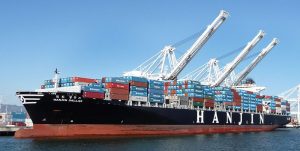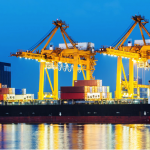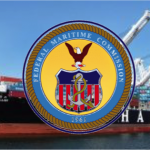Hanjin Collapses – How Badly Will it Hurt U.S. Shippers?

Hanjin Container Ship Photo by: Flickr user Ingrid Taylar
There could not have been a worse time for one of international shipping’s major ocean carriers to sink than peak season. However, that’s exactly what’s happened with Hanjin Shipping.
South Korea’s biggest carrier suddenly--and not so suddenly--collapsed this week.
Reuters reported (as published by CNBC:
Hanjin on Wednesday filed for court receivership after its banks decided to end financial support, and ports from China to Spain, the United States and Canada have refused entry to Hanjin vessels in what is traditionally the industry’s busiest season ahead of the year-end holidays.
Perhaps it is the timing that is causing Hanjin’s bankruptcy filing to send shockwaves through the international shipping industry. It was no secret that Hanjin was struggling. In fact, regular readers of this blog aren’t shocked at all by Hanjin’s bankruptcy after reading posts such as these this summer:
THINGS GET WORSE FOR HANJIN
S. KOREAN CARRIERS HANJIN & HMM COULD BE FORCED INTO MERGER
Whether U.S. shippers expected it or not, Hanjin going into receivership affects them. Right now is the busiest time for international shipping as shippers gear up for the holiday season, and that drastically increases the impact of Hanjin’s bankruptcy.
Here are 3 ways shippers are impacted by this major bankruptcy:
Shipment Disruption/Delays
Shippers with cargo on Hanjin ships right now are in a tough spot.
The Reuters quote at the top of this post mentions ports in countries around the world, including the U.S., are refusing entry by Hanjin vessels. A Bloomberg article adds some detail about Hanjin cargo ships unable to berth in the U.S.:
Three Hanjin vessels were stranded off the U.S. West Coast, Kip Louttit, executive director of the Marine Exchange of Southern California said. Large container ships that come within 20 miles of the port complex owe the exchange fees of as much as $1,000, while harbor pilots and tug-boat operators also receive payments for their services to incoming vessels, Louttit said in a telephone interview, without elaborating on the reason for the status of the Hanjin ships.
How long it will take those vessels, with U.S. shippers’ cargo onboard, to get cleared to dock is anyone’s guess.
While this is a major delay for shippers with goods on these ships, delays could also trickle to other shippers whose goods are moving through the ports. Sudden off-schedule clearance for these Hanjin cargo vessels to dock and unload could generate some port congestion.
Decreased Capacity
Reuters points out that Hanjin is the world’s seventh-largest container shipper, making this the international shipping industry’s biggest bankruptcy ever in terms of capacity.
We’ve been talking about the industry struggling with overcapacity in this blog for years. Carriers have been struggling with profitability, creating a “something’s gotta give” situation. This is a major give.
While overcapacity is bad for carriers, it is--generally speaking--a good thing for shippers. Peak season, when the most cargo is normally being shipped, is not when shippers want to see capacity decrease.
This capacity issue is not limited to cargo space on vessels importing goods to the U.S. While Hanjin ships aren’t being allowed to dock, ports also are not taking exports that were bound for Hanjin ships. That has exporters in the U.S. scrambling to reroute cargo to other carriers.
Therefore, the supply chain is majorly affected for both U.S. imports and exports.
Trucking has to be rescheduled or changed altogether. There are truckers and trucking companies counting on Hanjin for large bulks of income. These companies could quickly go under altogether, along with Hanjin. With the sudden surge in shipping activity and grabbing at space during the already busy peak season, carriers gain advantage over shippers, and that means…
Increased Freight Rates
Not surprisingly, freight rates from South Korea to the U.S. jumped immediately upon Hanjin’s bankruptcy. The Bloomberg article states:
Freight charges from South Korea surged about 50 percent after Hanjin Shipping filed for court receivership Wednesday, Korea Economic Daily reported, citing shipping industry officials it didn’t identify. The fees on Hanjin’s main shipping route between Busan and Los Angeles have jumped 55 percent to $1,700 per 40-foot equivalent box from $1,100, it said.
The effect on freight rates is further reaching than just that.
With overcapacity, carriers have struggled to make General Rate Increases (GRIs) to fight the downward pressure on freight rates stick.
With thousands of shippers scrambling for cargo space, carriers are standing firm on September GRIs, even announcing such rate increases in light of Hanjin’s bankruptcy. This means shippers can expect to pay more for their international shipping here in September than last month.
So What Happens Now?
We blogged before how South Korea may force a merger between Hanjin and Hyundai Merchant Marine (HMM). Universal Cargo was told in an email from a colleague in Hong Kong that the South Korean government is considering approval of the measure of merging due to the critical nature of this situation.
Either way, it looks like we’re about to see one less major carrier in the ever shrinking competition pool of ocean carriers.





Should be no surprise and those who chose to use them in last three weeks either don’t pay attention or
took the lowest rates available and felt things would be OK. The shrinkage in the industry has been predicted
for last 3 to 5 years and this year with APL, UASC and now Hanjin gone, coming to fruition. It will take another
3 to 5 years and there will be 10 left.
Welcome back Gary, we missed you!
I agree, the only way the industry becomes profitable again is through contraction of providers.
Thanks, Gary. Preach it!